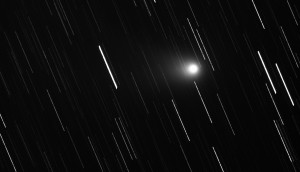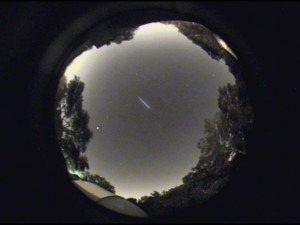The weather has been very spotty recently. To add to the frustration, work nights leave little time to observe with astronomical twilight not ending until after 9PM. But a week ago last Thursday the clouds cleared enough so that I was able to get one target of interest covered and then last Thursday the automated motion detection system of the All Sky Cam support software caught another.
”] Comet C/2009 P1 (Garradd) is currently in the Pegasus constellation. As the image shows it is fairly bright and it will continue to slowly brighten until Feb of next year. It will peak just under naked-eye visibility but should be an easy binocular object.
Comet C/2009 P1 (Garradd) is currently in the Pegasus constellation. As the image shows it is fairly bright and it will continue to slowly brighten until Feb of next year. It will peak just under naked-eye visibility but should be an easy binocular object.
The image is a stack of 120 thirty second exposures with the stack aligned to the comet leaving the stars trailed. I reported the comet at a magnitude of 11.4.
This is the first motion detection captured by the sky camera’s automated system. I’ve checked several sources that report satellite positions and this appears to be a legitimate meteor. It looks like the camera can take and save about 4 frames a second and it archives an image once every minute. The motion detection system will save the image that the motion is detected on along with the preceding image. This streak is only on two frames.
The meteor is quite bright. The bright object to the right of the left tree line is Jupiter at a magnitude of -2.5. Vega is visible in the prominent notch on the left edge of the right tree line. Its magnitude is 0.0.
